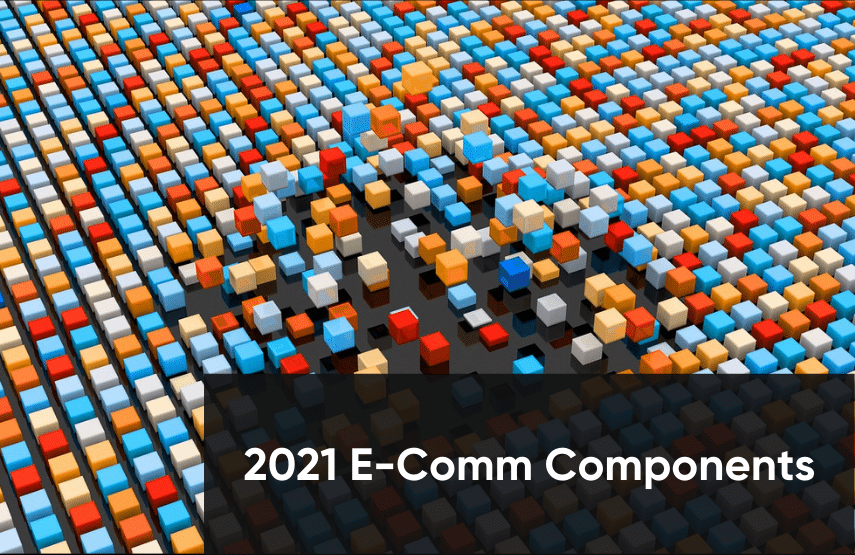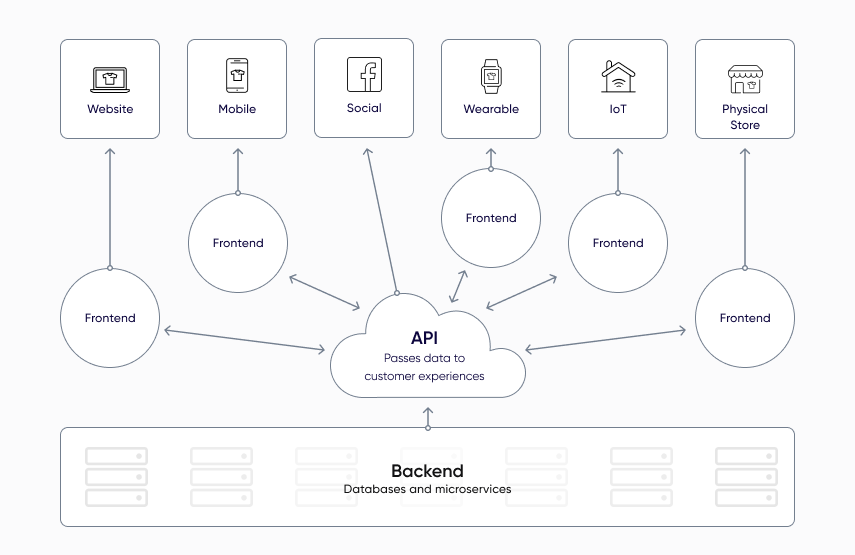23 E-Commerce Components to Sustain Growth in 2021

2020 has been an unprecedented year for e-commerce. While sales were expected to grow at a steady rate, nobody could have predicted the global pandemic that would help year-over-year e-commerce sales increase by 71% and 55% during the second and third quarters, respectively.
As we move into 2021, online retailers are determining how to prepare their e-commerce systems for continued growth. Fabric’s team recently met with a customer and fast-growing online retailer to discuss ways to do this. Many e-commerce components related to personalization, content, and omnichannel selling were broken down and prioritized.
In this post, we will outline some of the e-commerce components that this customer plans to implement into their systems and overall strategy for continued success in 2021. You can benefit from implementing many of these components, too.
But, before we dive into the different e-commerce components worthy of consideration for 2021, we first need to discuss a prerequisite for adding these components to your existing systems: headless commerce.
[toc-embed headline=”Prerequisite for 2021 E-Commerce Success”]
Prerequisite for 2021 E-Commerce Success
Headless commerce is an e-commerce architecture where the customer-facing frontend (e.g. the head) is separated from the backend where e-commerce components are created, developed, and iterated on by engineering teams. These components are often referred to as microservices. They are developed independently and integrated into frontend systems via API.

Headless commerce setups are future-proof as their flexibility allows you to seamlessly make updates and add components over time. When you use a monolithic platform, changing a single component can affect the entire system, resulting in prolonged downtime. (It’s similar to how activating a new plugin on WordPress can take down an entire site.)
With a headless setup, all the components are decoupled meaning you can update a single part without bringing the whole system down. This provides companies the agility necessary to stay competitive as you can quickly adapt to any changes in the market by adding new functionality or integrating new sales channels at will.
[toc-embed headline=”E-Commerce Components for 2021 Success”]
E-Commerce Components for 2021 Success
To help you prepare your e-commerce system for success, we’ve compiled a list of the components, features, and technologies you’ll want to consider adding in 2021. Again, this list is based on a 2021 planning discussion the Fabric team had with a fast-growing online retailer.
Personalization
1. Dynamic pricing
Dynamic pricing allows you to automatically present customers with different prices based on their unique characteristics. A simple way to add dynamic pricing to your e-commerce solution is through a promotions engine.
With a promotions engine, you can use machine learning to dynamically set prices depending on location, funnel-stage, or other factors.
2. Personalized offers
Personalized promotional offers can help increase conversions by presenting the right person with the right offer at the right time.
A promotions engine like Fabric’s Offers is great for this as well. You can plug it into your existing e-commerce system and leverage your customer data to create promotions personalized to each individual.
3. Product recommendations
Product recommendations help provide a highly personalized shopping experience by presenting customers with products based on their interests.
You can use a product recommendation engine to analyze large amounts of behavioral data to find the most relevant products to display, helping to increase conversions, average order value, and time on site.
Content
4. Rich content and video
Rich product content helps your listings stand out by providing customers more appealing material such as videos, reviews, and detailed descriptions to evaluate your products.
You can use product information management (PIM) software to enrich your products with reviews and descriptions optimized for customer preferences.
5. Visual search
Visual search allows customers to search for products through a photo instead of a keyword.
One way to incorporate visual search into your e-commerce strategy is to integrate a visual search tool directly into your app or web-store as Target has done.
You can also add Pinterest’s Save button to your website to make your products accessible to visual searches on their platform.
6. 360º product photography
360º product photography makes product pages more engaging as customers are able to use their mouse to rotate a product to see it from any angle they chose.
This not only improves the shopping experience, but it also helps reduce returns as customers can get a better understanding of the product before completing their purchase.
7. Augmented reality
Augmented reality (AR) provides shoppers a visual preview of a product in their own environment. This could be a furniture company that allows you to add a piece of furniture to a picture of your living space to see how it will fit or a clothing company that enables you to add different items to pictures of yourself.
AR provides a better representation of your products making it easier for consumers to make a purchasing decision.
8. Integrated blog
Blogs provide a great platform to provide rich content and storytelling to your audience. With a headless architecture, you can use a headless CMS to create a custom front end experience unique to your blog.
Brick and Mortar
9. Seamless point of sale integration
Point of sale (POS) integration provides a connection between your offline and online selling platforms, helping to improve both customer experience and operational efficiency.
When you use a distributed architecture built with APIs, it is easy to connect your POS system to all parts of your e-commerce infrastructure.
10. Buy online pickup in-store (BOPIS)
Buy online pickup in-store has exploded in 2020 as buyers have needed a safer way to shop for products. If you have a physical store and want to offer BOPIS, your e-commerce solution needs to have real-time inventory data and flexible checkout options for customers.
11. Showrooming
Showrooming is the process of viewing a product in-store before purchasing it online. It provides unique benefits as customers are usually able to save when buying online but are they are also able to see the product first-hand.
For this to work, you will need to provide available locations on your product pages that are synced to your inventory in real-time.
Technology
12. Cloud Hosting
Cloud hosting has near infinite capacity, allowing businesses to scale their e-commerce infrastructure with ease. Cloud solutions also provide a centralized database that can be easily connected to all parts of your e-commerce ecosystem.
13. Machine learning
Machine learning plays an integral role in some of the components previously listed including dynamic pricing and personalized offers. However, it has additional uses for modern e-commerce including fraud protection, demand forecasting, and optimized search functionality.
14. Chatbots
“Conversational commerce” continues to grow as more buyers are connecting with businesses through messenger apps. Chatbots work 24/7 to provide customers instant engagement and can use AI to understand their interests to create personalized shopping experiences.
15. Robust catalog management
Multichannel retailers with large catalogs need a robust solution to manage their product data.
PIM software provides a centralized hub for managing product data and can scale effortlessly in the cloud. With Fabric’s PIM, you can share product data across sales channels knowing it is always accurate and up to date.
16. Advanced data collection and analytics
E-commerce solutions must be able to capture, store, and organize customer data at scale. This data allows you to understand the behavioral and demographic characteristics of your customers and is the foundation of creating personalized experiences.
Conversion Rate Optimization
17. Seamless A/B testing
A/B testing allows you to test different elements of your front end display to see which are impacting the customer experience.
With a digital experience platform like Fabric’s XPM, you can keep multiple page versions to quickly run A/B tests to optimize engagement.
18. One-click checkout
One-click checkout creates a more seamless shopping experience by removing friction from the checkout process. Instead of adding items to a cart and needing to complete the purchase on the checkout page, customers can buy products individually straight from the product page with the click of a button.
19. Product customization
This allows shoppers to customize different aspects of a product. For example, a furniture retailer could allow buyers to customize the size or material of a particular item before adding it to their cart.
Giving customers the ability to customize the exact details of your products can lead to higher conversions.
Mobile
20. Mobile-friendliness
E-commerce solutions must make mobile a priority as more purchases take place on smartphones than on desktops or laptops.
With a headless setup, you can craft front end experiences unique to mobile devices that are optimized for engagement and performance.
21. Mobile Wallets
Support for mobile wallets like Google Pay and Apple Pay can help increase sales on mobile devices by removing friction during the buying process.
Card security is one of the biggest causes of cart abandonment. By allowing customers to checkout via a trusted brand like Apple, you can alleviate this concern.
22. Progressive Web Apps
Progressive web apps (PWA) allow you to provide a native app like experience through your mobile site.
PWAs can cut the load time of your mobile site significantly, leading to an improved customer experience and better conversion rates.
B2B
23. Self-service
B2B buyers now expect shopping experiences similar to those in their personal lives, making it essential for B2B sellers to provide customers the ability to perform tasks like adding products to their cart and completing orders on their own.

Content marketer @ fabric. Previously marketing @ KHON-TV and Paramount Pictures.